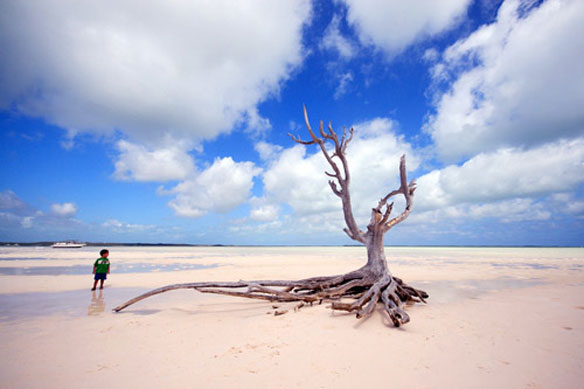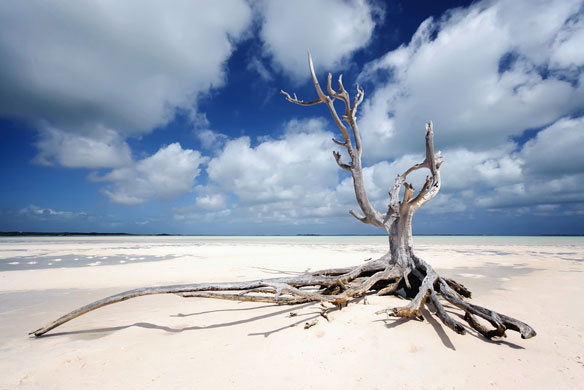
The lone tree, pink sand, on Eleuthera Island, Bahamas. Photo source: ©© MWeber
Excerpts; from Barbara Weibel, and from Lena Katz.
“We get to see rainbows all the time when it rains, but we’re always looking up at them. How many times do you get to look down and see one?”
Most beach sand color range from pale cream to golden to caramel, but in select places around the world, sands can be red, brown, pink, orange, gold, purple, green, and black.
Just how does this happen? Beaches can form anywhere the ocean meets the shore. Over millennia, waves scour the coastline, creating flat areas. These new expanses begins to accumulate sediments washing down from surrounding uplands, as well as those eroded from the ocean floor and tossed up onto shore by wave action. Coastal winds and storms push sediments up beyond the reach of the waves and a beach is born. The color of the sand on any particular beach usually reflects the surrounding landscape and the makeup of the adjoining ocean floor. Long-ago volcanic activity, crushed-up coral or nearby gemstone troves can cause sand to assume different shades.
White
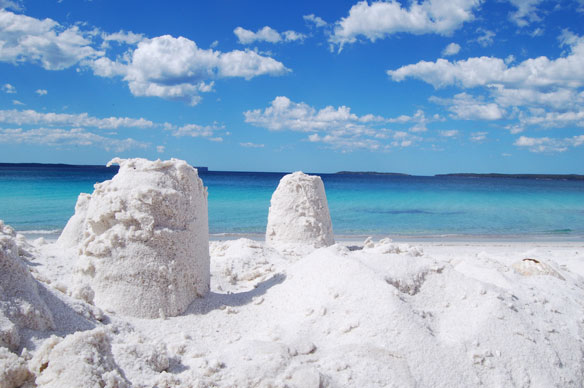
The startling white sands of Hyam’s Beach, Jervis Bay, Australia. Photo source: ©© Agent Smith
Hyams Beach is a village located in New South Wales, Australia and surrounded by three brilliantly white sand beaches, Chinaman’s Beach to the north, Hyams Beach and Seaman’s Beach to the south. Seaman’s Beach is the largest of the three beaches, stretching for approximately 2 kilometres (1.6 miles). Hyams Beach is present in the Guinness Book of Records as having the beaches with the whitest sand in the world. It is comprised of fine particles of quartz.
Green
Green sand beaches are very rare.

Papakōlea Beach, Hawaii. Photo source: ©© Ryan
Papakōlea Beach (also known as Green Sand Beach or Mahana Beach) is located near South Point, in the Kaʻū district of the island of Hawaiʻi. One of only four green sand beaches in the World, the others being Talofofo Beach, Guam, Punta Cormorant on Floreana Island in the Galapagos Islands, and Hornindalsvatnet, Norway. It gets its distinctive coloring from the mineral olivine. Captions: ©© Wikipedia
Two popular ones lie within the US: one on Papakolea Beach, Pu’u Mahana, in Mahana Bay on the Big Island of Hawaii, one in the territory of Guam, and the Galapagos Islands Punta Cormorant.
Green sand is composed primarily of olivine crystals which erode out of basalt (lava) flows. The crystals are heavier than most sand types on the beach and remain behind when lighter sand grains are washed away by strong wave activity. Olivine is a silicate mineral that contains iron and magnesium.
Pink
Pink beaches are also quite rare. They occur only in areas near a very large coral reef formations that contain a tiny organism that has a red skeleton, invertebrates such as corals, clams, forams and other shells.
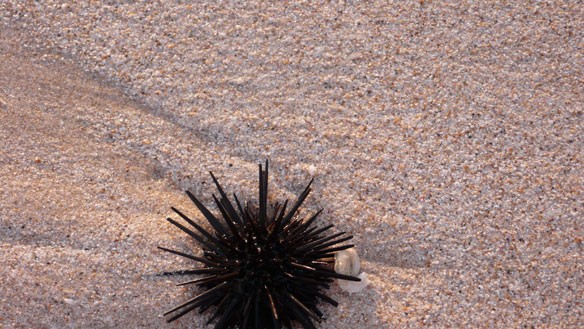
Photograph: © SAF — Coastal Care
When they die, these skeletons fall to the ocean floor and are gradually eroded to small particles that are carried to shore by the current, where they mix in with the sand. The finest example of a pink beach sand may be seen at Harbor Island, Eleuthera in the Bahamas, although pink beaches are also found in Puerto Rico, Bermuda, Barbados, the Philipines, and in Scotland.
Orange

Kappad beach, Kerala coast, India. Photo source: ©© Glory Oman Images
Ramla il-Hamra beach on the Maltese island of Gozo has orange colored sand, as does Porto Ferro, a mile-plus long orange sand beach backed by large dunes on the island of Sardinia off the coast of mainland Italy. Both of these islands are volcanic in nature, jutting up from the floor of the Mediterranean off the southern tip of Italy. Their orange colored sands derive from volcanic deposits as well as unusual orange limestone found in the area.
Red
There are very few red beaches in the world. They can be found in Hawaii, Rabida Island Galapagos or Santorini, Greece. The sand is composed mostly of iron.
Thanks to its unique geology, Hawaii has more colored sand beaches than anywhere else in the world. Located on the Hawaiian island of Maui, Kaihalulu Beach is tucked into a tiny pocket cove near Hana Bay, on the eastern half of the island. One of a very few red beaches in the world, the sand gets its red-black color from the iron-rich crumbling cinder cone hill surrounding the bay.
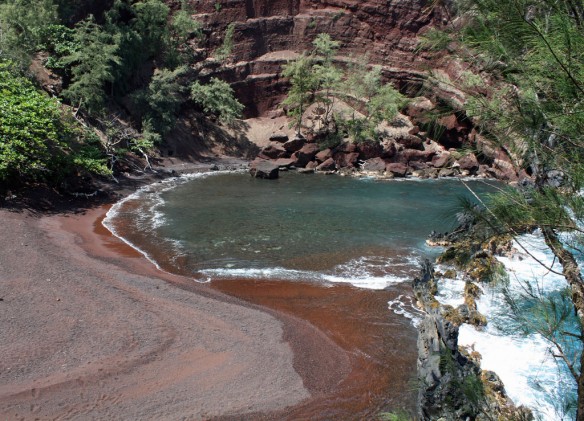
Maui. Photo source: ©© Hebert Farnsworth
Purple-mauve
When the manganese garnet in the hills surrounding Pfeiffer Beach in California’s Big Sur gets washed down to the ocean it turn the sand a vivid purple color. The further north you go, the more purplish the sand becomes.
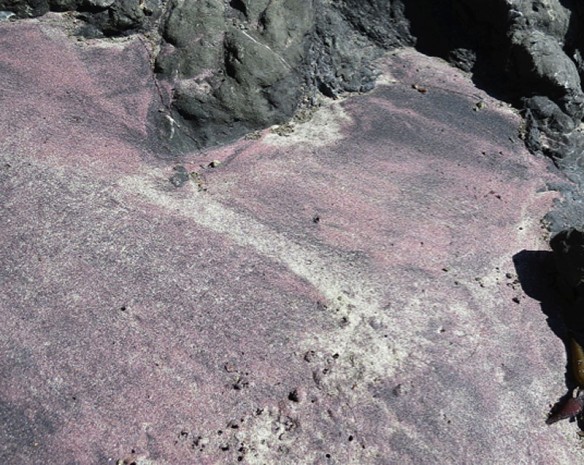
Purple sand, Monterey Bay at the mouth of the Big Sur River, California. Photo courtesy of: © Gary Griggs
Depending upon the day, the sands can sparkle in shades of violet, lavender, ruby red, pink, or royal purple. On the opposite side of the continent, mountains northwest of Long Island contain the mineral piedmontite, which also turns coastal sands purple.
Chocolate
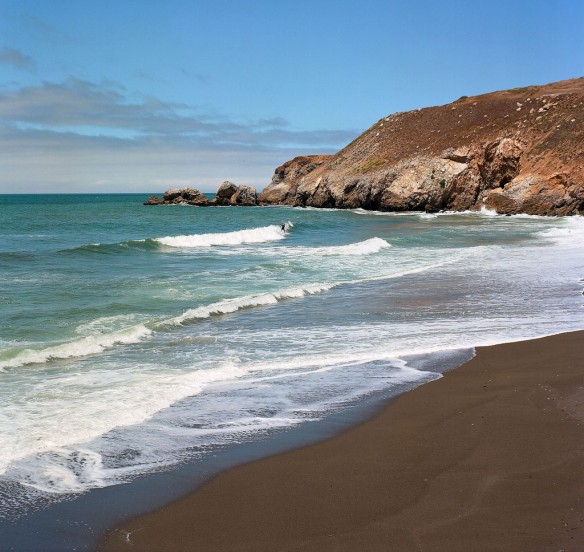
Rockaway Beach in Pacifica, California. ©© Michael Fraley
Rockaway Beach in Pacifica, California, exhibits a most luscious shade of chocolate brown.
This unusual color occurs when eroded bluish-grey limestone mixes with volcanic greenstone from the hillsides that ring the beach.
Rainbow
And then there’s Rainbow Beach on Fraser Island in Australia. Seemingly unable to make up its mind, Rainbow Beach displays more than 70 different colors whenever waves and winds shift and blow its sands around.
Most of the colors can be clearly seen in the cliffs behind the beach, which formed during the last ice age and are so richly banded that they have been compared to layers of rainbow sherbet. But for a real treat, dig down into the beach sand to see layer upon layer of colored, banded sands that create a new work of art with each sweep of the hand.
Black
Since this roundup of rainbow beaches began with white (technically, the blending of all colors), it seems appropriate to end with black, which is the absence of color. While that may be true in scientific terms, there is no absence of color at the world’s black sand beaches – they are simply a stunning result of volcanic activity near a coastline.
Black sand can be seen as a layer on top of silica sand in regions with high wave energy, on the flanks of volcanoes, and in areas where most of the source rock is mafic, or dark-colored and poor in silica. It can be composed of a number of different dark minerals – most are iron-rich and heavier than silica sand. This weight enables it to remain when high-energy waves wash the lighter sand grains out into the surf zone.

La Réunion Island, black sand. Photograph: © SAF — Coastal Care
The black sands are also a source of gemstones such as garnets, rubies, sapphires, topaz, and, of course, diamonds, which form within volcanoes and are spewed out during eruptions. Black sand beaches can be found to name a few, in Argentina, the South Pacific Islands, Tahiti, the Philipines, California, Greece, Antilles, Mascareignes islands, the Dominican Republic, Hawaii.

